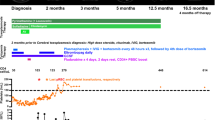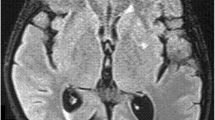Opinion statement
The choice of drugs for treating cerebral toxoplasmosis is limited. There are only three drugs available, and, of these, pyrimethamine and sulfonamide are invariably used in combination. Clindamycin is an alternative choice. Another drug, spiramycin, has poor central nervous system penetration, but achieves high concentrations in the placenta, and it is useful for treatment of toxoplasmosis during pregnancy. Because long-term maintenance therapy is often necessary, particularly in patients with AIDS, a wider choice of antibiotics is urgently necessary, because of potential problems with drug resistance and side effects. Treatment may be started empirically in any patient with HIV infection and multiple brain lesions. The drugs of choice are a combination of sulfadiazine and pyrimethamine. Folinic acid should be added to prevent pyrimethamine-induced bone marrow suppression. Repeated neuroimaging, 2 weeks after initiating therapy, is needed to assess efficacy of treatment. If CD4 cell counts remain below 100 cells per mm3, lifelong therapy is needed. Tissue diagnosis should be established in patients who do not respond to treatment, who have solitary lesions, or in patients without AIDS. Recent breakthroughs in the understanding of the biology of Toxoplasma will result in the development of a range of new therapies in the near future.
Similar content being viewed by others
References and Recommended Reading
Tenter AM, Heckeroth AR, Weiss LM: Toxoplasma gondii: from animals to humans. Int J Parasitol 2000, 30:1217–1258.
Belanger F, Derouin F, Grangeot-Keros L, Meyer L: Incidence and risk factors of toxoplasmosis in a cohort of human immunodeficiency virus-infected patients: 1988–1995. HEMOCO and SEROCO Study Groups. Clin Infect Dis 1999, 28:575–581.
Nath A, Jankovic J, Pettigrew LC: Movement disorders and AIDS. Neurology 1987, 37:37–41.
Nath A, Hobson DE, Russel A: Movement disorders with cerebral toxoplasmosis and AIDS. Mov Disord 1993, 8:107–112. Reviews the unique clinical manifestations of cerebral toxoplasmosis with HIV infection.
Adan-Civera A, Mondelo-Mondelo FJ: Pathology of the retina in patients with AIDS. Rev Neurol 1996, 24:1614–1618.
Khan EA, Correa AG: Toxoplasmosis of the central nervous system in non-human immunodeficiency virus infected children: case report and review of the literature. Pediatr Infect Dis J 1997, 16:611–618.
Dubey JP: Advances in the life cycle of Toxoplasma gondii. Int J Parasitol 1998, 28:1019–1024.
Sinai AP, Joiner KA: Safe haven: the cell biology of nonfusogenic pathogen vacuoles. Ann Rev Microbiol 1997, 51:415–462.
Weiss LM, Kim K: The development and biology of bradyzoites of Toxoplasma gondii. Front Biosci 2000, 5:D391-D405.
Lingelbach K, Joiner K: The parasitophorous vacuole membrane surrounding Plasmodium and Toxoplasma: an unusual compartment in infected cells. J Cell Sci 1998, 111:1467–1475.
Sinai AP, Webster P, Joiner KA: Association of host cell endoplasmic reticulum and mitochondria with the Toxoplasma gondii parasitophorous vacuole membrane: a high affinity interaction. J Cell Sci 1997, 110:2117–2128.
Coppens I, Sinai AP, Joiner KA: Toxoplasma gondii exploits host low-density lipoprotein receptormediated endocytosis for cholesterol acquisition. J Cell Biol 2000, 149:167–180.
Blader I, Manger I, Boothroyd J: Microarray analysis reveals previously unknown changes in Toxoplasma gondii infected human cells. J Biol Chem 2001, 276:24223–24231.
Sarciron ME, Gherardi A: Cytokines involved in Toxoplasmic encephalitis. Scand J Immunol 2000, 52:534–543.
Yap GS, Sher A: Cell-mediated immunity to Toxoplasma gondii: initiation, regulation and effector function. Immunobiology 1999, 201:240–247.
Boothroyd JC, Hehl A, Knoll LJ, Manger ID: The surface of Toxoplasma: more and less. Int J Parasitol 1998, 28:3–9.
Derouin F, Leport C, Pueyo S, et al.: Predictive value of Toxoplasma gondii antibody titres on the occurrence of toxoplasmic encephalitis in HIV-infected patients. ANRS 005/ACTG 154 Trial Group. AIDS 1996, 10:1521–1527.
Cingolani A, De Luca A, Ammassari A, et al.: PCR detection of Toxoplasma gondii DNA in CSF for the differential diagnosis of AIDS-related focal brain lesions. J Med Microbiol 1996, 45:572–576.
Brightbill TC, Post MJ, Hensley GT, Ruiz A: MR of Toxoplasma encephalitis: signal characteristics on T2-weighted images and pathologic correlation. J Comput Assist Tomogr 1996, 20:417–422.
Cohn JA, McMeeking A, Cohen W, et al.: Evaluation of the policy of empiric treatment of suspected Toxoplasma encephalitis in patients with the acquired immunodeficiency syndrome. Am J Med 1989, 86:521–527.
Katlama C, De Wit S, O’Doherty E, et al.: Pyrimethamine-clindamycin vs. pyrimethaminesulfadiazine as acute and long-term therapy for toxoplasmic encephalitis in patients with AIDS. Clin Infect Dis 1996, 22:268–275. Important clinical trial for basis of current management of cerebral toxoplasmosis.
McFadden GI, Roos DS: Apicomplexan plastids as drug targets. Trends Microbiol 1999, 7:328–333. Describes future approaches to drug development in the treatment of toxoplasmosis.
Roos DS, Crawford MJ, Donald RG, et al.: Origin, targeting, and function of the apicomplexan plastid. Curr Opin Microbiol 1999, 2:426–432.
Kohler S, Delwiche CF, Denny PW, et al.: A plastid of probable green algal origin in Apicomplexan parasites. Science 1997, 275:1485–1489.
Waller RF, Keeling PJ, Donald RG, et al.: Nuclearencoded proteins target to the plastid in Toxoplasma gondii and Plasmodium falciparum. Proc Natl Acad Sci U S A 1998, 95:12352–12357.
Fichera ME, Bhopale MK, Roos DS: In vitro assays elucidate peculiar kinetics of clindamycin action against Toxoplasma gondii. Antimicrob Agents Chemother 1995, 39:1530–1537.
Roberts F, Roberts CW, Johnson JJ, et al.: Evidence for the shikimate pathway in apicomplexan parasites. Nature 1998, 393:801–805.
McFadden DC, Tomavo S, Berry EA, Boothroyd JC: Characterization of cytochrome b from Toxoplasma gondii and Q(o) domain mutations as a mechanism of atovaquone-resistance. Mol Biochem Parasitol 2000, 108:1–12.
USPHS/IDSA Working Group: 1997 USPHS/IDSA guidelines for the prevention of opportunistic infections in persons infected with human immunodeficiency virus. Ann Intern Med 1997, 127:923–946. This contains important information that can be provided to all patients with HIV infection to prevent toxoplasmosis.
Mussini C, Pezzotti P, Govoni A, et al.: Discontinuation of primary prophylaxis for Pneumocystis carinii pneumonia and toxoplasmic encephalitis in human immunodeficiency virus type-1-infected patients: the changes in opportunistic prophylaxis study. J infect Dis 2000, 181:1635–1642.
Soriano V, Dona C, Rodriguez-Rosado et al.: Discontinuation of secondary prophylaxis for opportunistic infections in HIV-infected patients receiving highly active antiretroviral therapy. AIDS 2000, 14:383–386. Provides important new guidelines on stopping anti-Toxoplasma therapy in patients with AIDS and toxoplasmosis.
Stout JE, Lai JC, Giner J, Hamilton CD: Reactivation of retinal toxoplasmosis despite evidence of immune response to highly active antiretroviral therapy. Clin Infect Dis 2002, 35:37–39.
Author information
Authors and Affiliations
Rights and permissions
About this article
Cite this article
Nath, A., Sinai, A.P. Cerebral toxoplasmosis. Curr Treat Options Neurol 5, 3–12 (2003). https://doi.org/10.1007/s11940-003-0018-8
Issue Date:
DOI: https://doi.org/10.1007/s11940-003-0018-8




